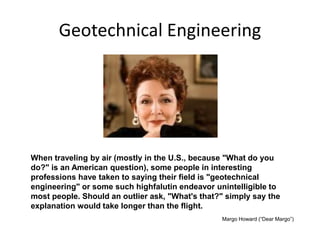Rumored Buzz on Geotheta
Rumored Buzz on Geotheta
Blog Article
The Ultimate Guide To Geotheta
Table of Contents4 Easy Facts About Geotheta DescribedThe Single Strategy To Use For GeothetaGeotheta - QuestionsGeotheta Can Be Fun For Anyone
They collaborate with civil engineers, structural designers, engineers, and other experts to incorporate geotechnical factors to consider into the total task layout and building and construction process. This needs effective teamwork, coordination, and interaction to make sure that the geotechnical aspects straighten with the task purposes and meet regulatory needs.Mining & Materials Engineering: Principles of boring, penetration rates, and variables affecting the selection of drilling approach. Characteristics of nitroglycerins, firing systems and blast patterns. Blasting methods in surface area and below ground workings. Special blowing up strategies at excavation borders. Vibration and sound control. Mechanical and continual approaches to fragmentation, including longwall shearing and fullface boring.
Integrated evaluation of fragmentation and comminution procedures. Provided by: Mining & Materials Engineering.
Our Geotheta Ideas
Bachelor's degree programs in civil, geotechnical, geological, and environmental design normally last 4 years and include basic education programs in English, social science, and the liberal arts, along with training courses in sophisticated maths, architectural geology, and fluid mineralogy. (https://canvas.instructure.com/eportfolios/3071866/Home/Why_Geotechnical_Engineers_Are_Essential_for_Your_Construction_Projects)
Geotechnical engineering involves the evaluation of the soil and rock conditions at a certain website, and their implications for the development of that site. As a lot of frameworks count on the ground for support, it is without surprise that a thorough understanding of the ground conditions, and the suitability of foundation systems, are essential to the lasting stability and performance of the building or framework.
Specialising in the investigation of geological formations and ground behavior, geotechnical designers execute scientific examinations and screening to understand the impact these geological formations might have on the layout and building and construction of building, civil and facilities jobs. This proficiency is vital for the style and construction of buildings, roads, passages, dams, bridges, and water and sewer system.
The geotechnical team at Douglas Allies consistently speak with engineers, layout engineers, designers, and home builders to make recommendations on style and advancement proposals to make sure that the developed structures are suitably made for the ground conditions. The layout of footing systems needs to consider the weight of the framework, the ability of the ground to support that weight with each other with activity tolerances and reliable building and construction.
Geotheta Fundamentals Explained
This task is substantially streamlined by the usage of our Douglas Map geospatial platform that makes this information readily easily accessible in a very easy to make use of internet browser interface. A geotechnical designer will certainly guide the boring of boreholes and examination pits to gather dirt and various other samples, and likewise analyze surface area features and ground direct exposures to create a geotechnical version of the subsurface conditions.
Depending upon the task kind and ground problems ran into, lab testing might amongst various other things evaluate stamina, compressibility, sensitivity and/or leaks in the structure of soil and rock samples. Hereafter information is collected and collected, the outcomes are used for a geotechnical version of the site, which is typically provided as sections throughout the site.

A geotechnical investigation naturally can just evaluate the ground problems at the places pierced or dug deep into. All-natural variations in soil and rock problems can take place across a site and in between examination areas. It is consequently great technique that the geotechnical engineer be maintained throughout construction of the task to provide on-site confirmation that the ground problems come across follow the assumptions and advice given in the geotechnical investigation report.
The Ultimate Guide To Geotheta
Geotechnical designers utilize their in-depth expertise of dirt and rock to assess risk and address issues on diverse framework projectsGeotechnical design is a specialist branch of civil design which checks out the behavior imp source of planet materials and the application of soil and rock technicians. Consulting Engineers. As a geotechnical designer, you will analyze the physical, mechanical and chemical residential or commercial properties of soil and rock in order to create foundations, keeping frameworks and earthworks
Geotechnical design is carefully connected to and overlaps with, both design geology and ground design - https://flossy-rotate-3d1.notion.site/Why-Geotechnical-Engineers-are-Vital-for-Your-Construction-Projects-7c147cf012a34d1abe5134afbabc811f?pvs=4. It's possible to be experts in geotechnics or job for a geotechnical business yet be referred to as a design rock hound or a ground designer. As a geotechnical designer, you'll need to: build and maintain partnerships with clients and other professionals involved in the website, throughout each projectmaintain safety criteria on site be conscious of cost ramifications when you make recommendationsstudy geological maps and aerial photographs from a series of sources and from different time periodsexamine construction intends to see how feasible they are based upon your understanding of the siteinvestigate threats or geological dangers for the sitesearch for environmentally sensitive attributes, such as land fill start to establish valid and expository ground modelsplan area investigationsdrill and analyse samples of bedrock, soil, groundwater and additional materials supervise various other experts on sitesolve technological issues as they develop, such as unforeseen structures at drill sitesmonitor conditions during and after construction to ensure structures are stable in the brief and long termadding information collected on site to your preliminary researchcreating geotechnical calculations, illustrations, and 2 or three-dimensional computer models analyzing the datamaking suggestions regarding the suggested use the site

Report this page